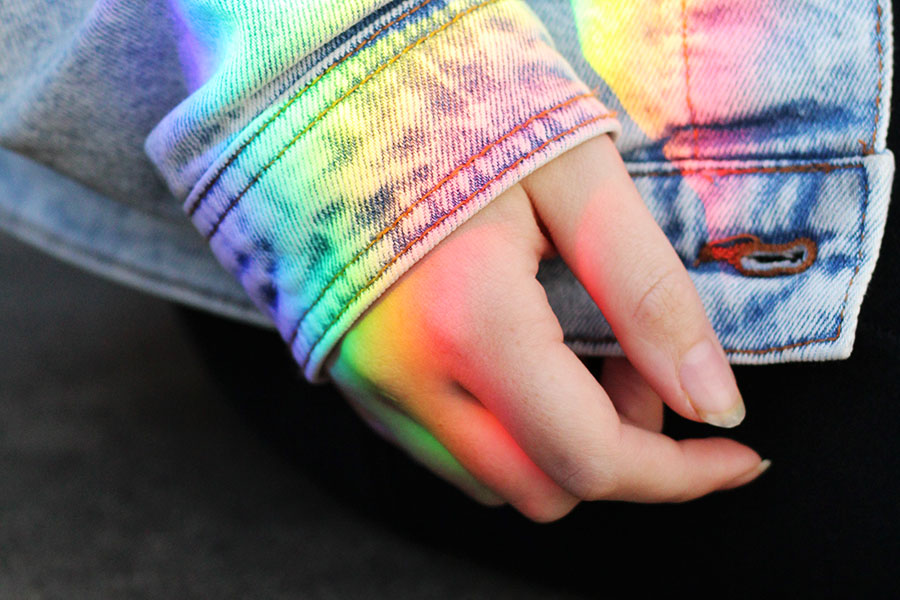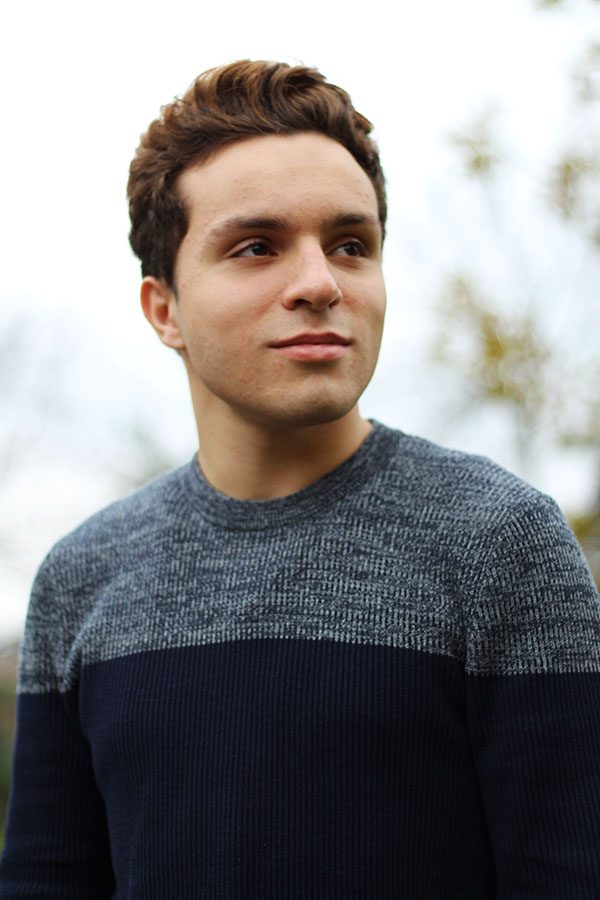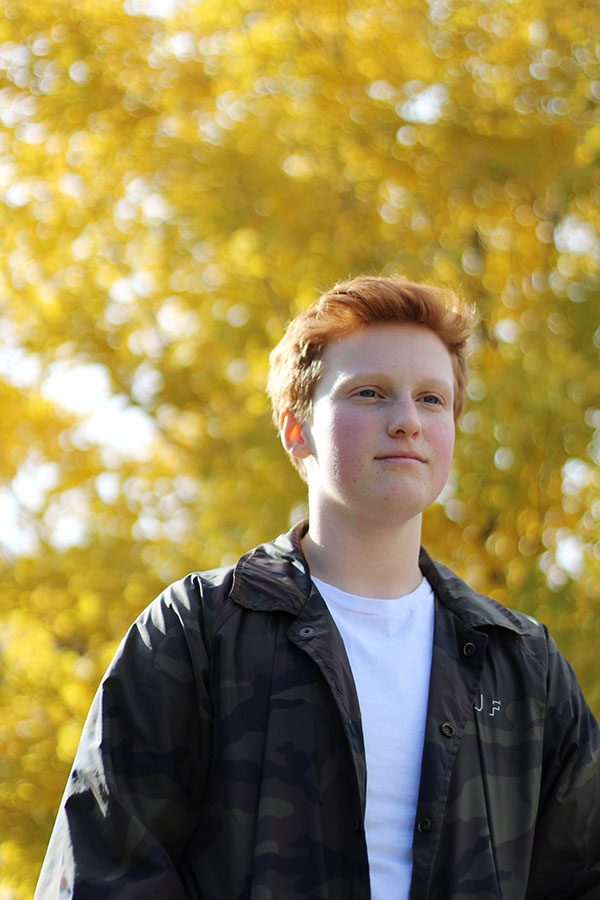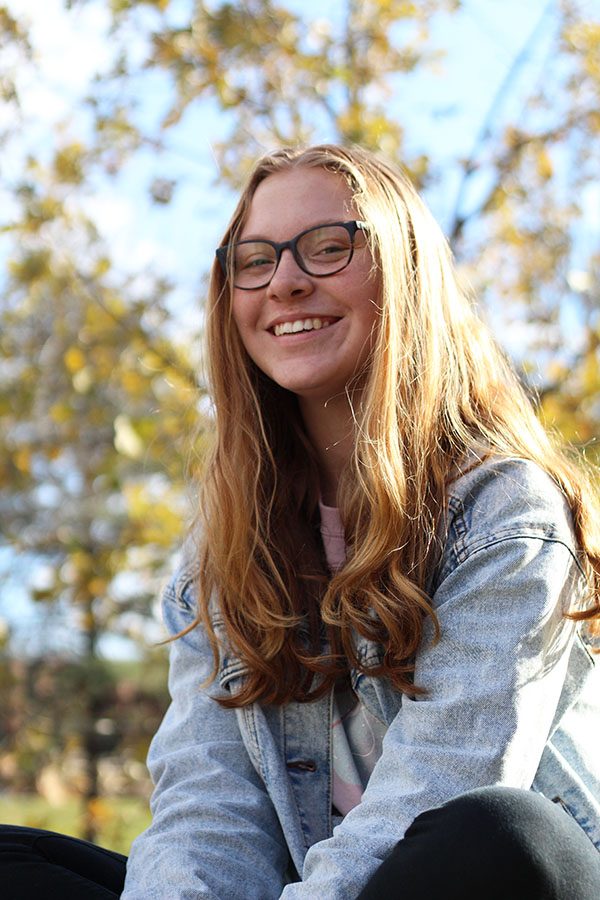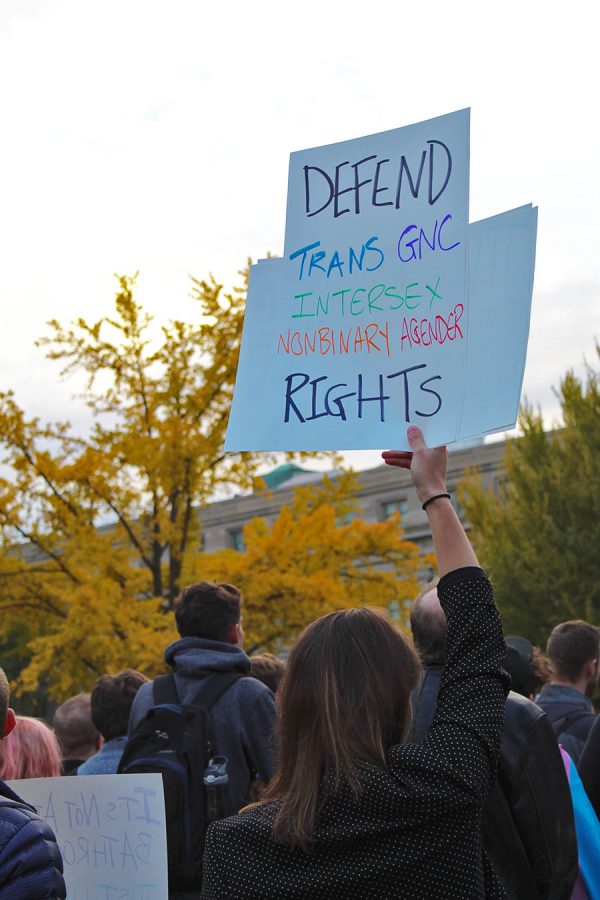Your donation will support the student journalists of West High School. Your contribution will allow us to purchase Scholarship Yearbooks, newsroom equipment and cover our annual website hosting costs.
A spectrum of perspectives
While progress has been made toward treating LGBTQ+ individuals equitably, challenges and stigmas still remain.
November 15, 2018
Appearances are not always what they seem.
Iowa City was recently recognized as an exceptionally accepting community for lesbian, gay, bisexual, transgender and queer individuals, receiving a perfect score on the 2018 Municipal Equality Index. This national report for city support of LGBTQ+ rights accounts for municipality characteristics such as city nondiscrimination protections and relationships with city leaders.
West High itself has a widely-promoted gender-sexuality alliance, called COLORS, supported by administration and staff. Teachers at large promote toleration of all individuals according to the district’s non-discrimination policy.
However, despite these outward impressions of diversity and acceptance, results from a 2018 district-wide survey revealed that “LGBTQ+ and non-binary students feel significantly less safe in and around school than non-LGBTQ+ and binary students.”
“I want the data to change. I want all of our students to feel safe. I want our staff to feel confident in how to respond,” said Laura Cottrell, the ICCSD’s Director for Diversity and Cultural Responsiveness. “I want all of our schools to be welcoming in every way, shape or form. It’s my goal to move those numbers.”
Crystal KimIn response to these survey results, the ICCSD and West High implemented changes for the 2018-19 school year, with the hope of enhancing quality of life for marginalized students. The most obvious change was Student Senate’s alterations to homecoming court. However, this decision received much backlash, including remarks directly made against LGBTQ+ and non-binary students.
“In an undercurrent of conversations that kids were having, there was obviously some not-great understanding and acceptance of gay students,” said Principal Gregg Shoultz. “We think that we’re a pretty progressive community, but that’s not uniform. There’s a lot of learning that has to go on.”
Addressing these concerns, perspectives from students, teachers and administrators alike outline the West experience of an LGBTQ+ or non-binary student and how the school hopes to cultivate a more positive, safer environment moving forward.
Gaining ground
Out of the groups represented in the LGBTQ+ community, lesbian, gay and bisexual members have perhaps had the most success in campaigning for civil rights legislation and visibility. Over the past 20 years, Supreme Court rulings legalized same-sex sexual conduct and eventually same-sex marriage. The rapid success of the gay rights movement has fostered more accepting coming-out experiences at West.
“No matter what, [coming out] is something you’re going to struggle with, but once you take that leap and actually come out, the [overall] West High environment is completely supportive,” said Breno Sader ’19, a gay student.
Michelle Kim ’20, a lesbian student, attributed newfound acceptance to the adjusting period that teachers and students have had to become acquainted with different sexualities.
“People are getting used to it,” Kim said. “It’s been a thing for a while that people don’t care about it.”
Albeit, the West community is still not perfect.
“There’s been a few occasions with people who aren’t okay with the fact that I’m gay,” Sader said. “Sometimes it’s that they don’t understand it and they’re curious about it, so they ask [generalizing] questions that they don’t really realize are homophobic.”
Psychology teacher Travis Henderson credits this ignorance to the idea that many students in the building who are heterosexual or cisgender are unaware of the mental dilemma faced by LGBTQ+ students.
“Part of the privilege of heterosexism is not having to think about their sexuality. Part of the privilege of being cisgender is not having to think about gender,” Henderson said.
According to Sader, rather than outwardly speaking against the LGBTQ+ community, peers are more likely to express discriminatory comments or homophobic actions discreetly.
“It’s not the remarks that I hear exactly; it’s just people who I know who are uncomfortable being around me,” Sader said. “They don’t like the fact that I’m gay; they don’t think it’s right, so they don’t want to be around me.”
Now, according to Henderson, discussions have shifted more towards promoting acceptance, not awareness.
“About half a decade ago, the fight was more about visibility,” Henderson said. “I don’t think people are asking for tolerance anymore or recognition of their existence. It’s not tolerance, it’s acceptance. It’s that [others] understand [the LGBTQ+ community’s] world view and they can empathize to some degree. And I think it’s 100 percent reasonable to be asking for those things.”
Erin Netolicky ’20, a bisexual student, believes part of this acceptance would come from greater discussions of LGBTQ+ individuals in history.
“There’s so many strong, powerful figures [whose] sexuality is not mentioned at all or covered up,” Netolicky said. “Not having anyone historical to look up to furthers this perception that it’s just a millennial thing or just a Gen Z thing and that it’s not real.”
Many students and families still fear ongoing discrimination in life outside of the school environment, as well.
“My mom wasn’t at first accepting of it. She was very worried about what the world would do to me,” Kim said. “She sees all this stuff in the news about gay people being discriminated against just because they’re gay. My mom was clearly afraid that I would have a disadvantage at life because of my sexuality.”
According to Netolicky, simply understanding others’ experiences is one of the most powerful actions society can take moving forward.
“It’s important to remember that [LGB students are] humans too,” Netolicky said. “We shouldn’t be othered because of things that we cannot change. I feel that we’re more alike than we are different. Realizing what similarities there are is the first step to bridging that gap.”
Breaking barriers
For many students, using public bathrooms is an occurrence that happens without another thought. But for transgender individuals at West, this seemingly ordinary event transforms into a time of ridicule and self-questioning.
Aaron Lidral ’19 made the transition from female to male during his junior year of high school and subsequently began using male restrooms. However, upon doing so, he started hearing laughter and snarky remarks.
“Within a couple weeks, I started noticing I’d just get weird looks and [comments like], ‘Why are you in here?’ … I felt unsafe,” Lidral said.
After facing harassment, Lidral went to school administration out of fear for his own safety. However, school administration did not take adequate action, forcing Lidral to change his mindset altogether.
“Last week, I could hear [a group of guys] saying, ‘Why the hell is he in a stall? Stand up like a man,’” Lidral recounted. “I just kept my head down, washed my hands and walked out. That’s just how I’ve had to approach it.”
Lidral’s concerns for personal safety are mirrored across the country, as transgender people are at high risk in public spaces. According to a 2015 U.S. Transgender Survey, 47 percent of transgender people are sexually assaulted within their lifetime at least once. During 2014, 46 percent of participants were verbally harassed and nine percent were physically attacked. Moreover, this discrimination, harassment and discomfort can lead to severe trauma at disproportionate rates for transgender students. 39 percent of transgender survey participants experienced serious psychological distress at a rate eight times higher than the U.S. population at large.
Emily Buck ’19, COLORS president, says that despite Iowa City’s progressive climate, discrimination is still a large part of the transgender and non-binary student experience.
“It seems like a lot of the struggles that non-binary folks and transgender folks go through are not widely seen in the school, even though they blatantly happen,” Buck said. “That creates a lot of invisibility for the trans and non-binary experience at West.”
The bathroom issue is an important one faced by the transgender and non-binary communities. This is because it is harder to protect students in areas where teachers or administrators are not always present.
“I would say that the school should do more to protect transgender individuals, but it’s just really hard, like how can you protect someone in a bathroom?” Lidral said. “That’s the main area where I think anyone who’s trans feels unsafe. Everyone’s vulnerable in a bathroom, but trans people especially.”
Last school year, West administration took steps to make the school a more inclusive environment by establishing a gender-neutral bathroom. Although this was a milestone for the West transgender community, discrimination still remains a struggle.
Moreover, there is a great stigma against transgender individuals even within the LGBTQ+ community. Harpur Barahona ’20 is a transgender female who experienced this stigma firsthand.
“During eighth grade, I was still figuring it out but also coming to terms with being who I am,” Barahona said. “There is a lot of stigma against trans people, and at the time, I didn’t want to identify with it, even though I knew that this is what I was … Then, I was trying to keep it back and go with different things so that I would be more normal even within the LGBT community, because there’s some people who go against one another in the community itself.”
“As long as something is not ‘the norm,’ it will always feel unsafe for people who don’t identify with that norm,” Buck said. “[Gender] is just now [becoming] an issue, and there has not been a lot of time to allow for change, especially in mindsets … It’s understandable that non-binary and transgender folks feel unsafe, no matter the political climate.”
Barahona had a simple message to perpetrators of disparaging remarks.
“I want to know if it’s worth it,” she said. “Because do you really feel good about yourself after making someone else feel like that? It really doesn’t make sense how you can be negative for no other reason than being negative.”
The locker room
High school locker rooms are a pertinent battleground for LGBTQ+ rights. According to a 2011 study by the Gay, Lesbian & Straight Education Network (GLSEN), 39 percent of LGBT students avoid these spaces. In addition, just 23.2 percent of LGBT students participate in interscholastic sports, compared to 47.8 percent of all high school students that same year.
The lack of openly LGBTQ+ student athletes partially stems from the language used in a typical locker room. “Out on the Fields,” an international study in 2015, found that 84 percent of gay men and 82 percent of lesbian women reported hearing homophobic slurs in the locker room. The study also found a direct correlation between these slurs and the number of closeted athletes.
The barrage of these remarks is intimidating for many closeted LGBTQ+ athletes. Evan Risk, an openly gay assistant boys track coach at City High, has heard his share of homophobic slurs used at practices.
“I was coaching this summer, and I heard some kids use that type of language to call each other ‘fags’ or ‘gay,’” Risk said. “I think a [closeted] kid hearing that and not understanding that they don’t mean it while he’s already scared and doesn’t want to [come out will] set him back further.”
Openly gay high school coaches are scarce. Because many LGBTQ+ students do not see people like them in leadership positions on their teams, they may become discouraged from coming out.
“When I think back to my high school experience, if I had come out, it probably wouldn’t have been a big deal,” Risk said. “But if I had an openly gay coach, or knew of one or knew of a big-time professional athlete who was gay, I think that would have really helped me.”
Perhaps most alarming, 79.4 percent of LGBTQ+ students feel they cannot have an open dialogue about their identity with their P.E. teacher or coach. West High Athletic Director Craig Huegel stresses the significance of having even one trusted adult.
“It’s important that you have an adult,” Huegel said. “It could be the custodian, it could be someone working in the lunchroom … but you need someone … that you feel comfortable having that conversation with.”
Huegel believes ensuring supportive cultures on teams is crucial, as athletics can unite a diverse population and benefit those involved.
“I think that’s the great part about sports: we have a common goal,” Huegel said. “No matter how you’re different, there’s one common thing we can all get behind and support … We want your teammates to support you no matter what personal problems you have, or what makes you different.”
Recognizing the importance of open participation in athletics, West’s athletic department has made strides in recent years to ensure opportunities for transgender students to participate.
“If we are able to allow those students to participate, they do. Students are allowed to participate with the gender that they identify with,” Huegel said. “[West is] certainly not perfect, but by and large, for the most part, kids are pretty accepting of others.”
However, some transgender individuals still make the choice to participate on the team that matches their sex at birth.
“I [didn’t] participate on the guys [swim] team just because I’d face a lot more microaggressions, like in the bathroom,” Lidral said. “I knew I would feel out of place on the girls team, but I thought I would actually feel more out of place on the boys team, just comparing myself to them constantly.”
Moving forward, the best initiative athletes and coaches can take is to be aware of the impact of their interactions with others.
“Last week I went to the safe-school training … [and] one of the teachers made the point that this is about more than just respecting each other,” Risk said. “If a kid is in a really bad spot, and you’re not an accepting teacher or coach, then that’s pretty serious and could lead to serious things for that student.”
Push for progress
During a “Support Trans Lives” protest on the Pentacrest, a woman holds up a sign in support of transgender rights on Thursday, Oct. 25.
In response to inadequate results on the district survey regarding LGBTQ+ and non-binary student experiences, district and West administration have cultivated an enhanced community.
One previously-mentioned change was redesigning homecoming court. Due to a recommendation from a district task force committee, West altered the previous homecoming court selection process to become gender-neutral and category free, making it more inclusive of the student body.
Another measure that the school district is taking to improve the LGBTQ+ school experience is instituting Safe Zone training taught by University of Iowa staff as an option for teachers. According to the Safe Zone Project, Safe Zone training provides “opportunities to learn about LGBTQ+ identities, gender and sexuality and examine prejudice, assumptions and privilege.”
Previously, teachers had the option to put up stickers acknowledging that their classrooms are safe spaces for LGBTQ+ students. However, over time, these stickers will come down, replaced by signs given only to teachers who are trained and qualified to be Safe Zone instructors.
“Hopefully, we can get every teacher safe-zone trained,” Henderson said. “They’ll have the knowledge to understand the issues and help students who are in a crisis.”
Sader believes this change is a positive step in encouraging teacher support of the community.
“I think that training is a fantastic idea,” Sader said. “I think that, again, education is key. If those teachers are educated on helping students, they should definitely earn those plaques.”
However, though significant changes were made to make West a more inclusive community, Shoultz does not believe that this process is complete.
“I think [that] we’ve been a leader in the past couple [of] years,” Shoultz said. “If you look at some of the work we’ve done, it’s pretty strong work, but it’s a process. I think we have done some things that have been at the forefront, but I don’t think that by any stretches of imagination we’re done.”
Students believe that one way West can continue improving is by providing more instruction on the issues faced by the LGBTQ+ community.
“There’s work to be done, and all of that work is educational,” Sader said. “You have to teach people about the LGBT community because as human beings, we’re afraid of the unknown … The more educated you are about different cultures, the more improved your life is going to be.”
Lidral praised these efforts, pointing to his own experience with teaching students about the transgender community as a reference for why LGBTQ+ individuals should be discussed more in the academic setting.
“In AP Psych, our teacher, [Travis] Henderson, has done a pretty good job of including gender and not forgetting about trans people in our lessons,” Lidral said. “That’s just nice to hear about. I think getting trans people into different discussions is a really good way to normalize it.”
As the new director of special equity projects, a division that emphasizes improving quality of educational life for minority students, Cottrell is looking for student voices to assist with helping improve even further.
“I know it is a courageous thing to reach out, but I hate having these conversations about what to do without having their voice at the table,” Cottrell said. “I have no voice from transitioning students, [and] it would be very valuable if I could get their feedback … I don’t feel right making those decisions without voices from people who are actually living it.”
Henderson reinforces that communication, validation and acceptance are ultimately what students in the LGBTQ+ community need.
“It does a lot of harm to have to live through your teenage years, some of your most formative years, and not be able to be yourself and really live your identity in that critical time,” Henderson said. “Obviously, we’ve got a lot of work to do, but I think we’re taking steps in the right direction.”

